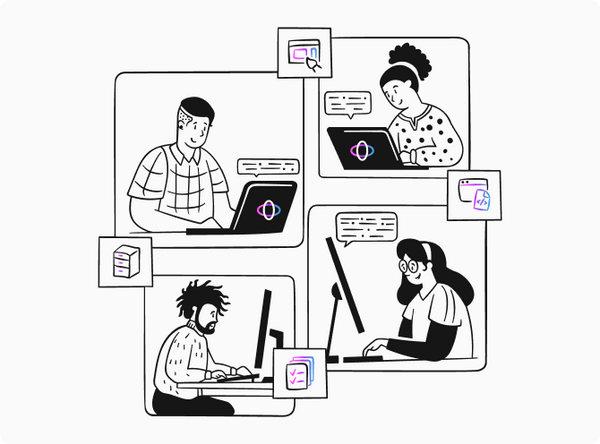
Unlocking the Power of MVPs: How to Develop an MVP That Will Boost Business Growth
 Jared Wild
Jared WildIn this highly competitive world that we live in today, it’s essential to stay abreast of technologies and innovations to have an edge over the competition. One of the best ways to do so is by developing a Minimum Viable Product (MVP). An MVP, as you can decipher from the name, is a product with a minimum set of features to satisfy first users and gather their feedback.
However, developing an MVP may not always come out that simple. To launch even a very simple project, it’s necessary to carefully plan features and put them together knowledgeably so that the MVP meets the needs of both the business and its customers.
In this guide, we explore why starting with an MVP is so important for businesses. We take a look at the key components of an effective MVP and provide tips on how to create an MVP to help businesses grow. Ready to dive in? If so, keep reading!
1. Why Start Product Development With an MVP
If you don’t have a significant amount of resources available, then building an MVP is an important step before launching a fully-fledged product. Not only is it less risky and more logical in terms of financial resources, but it also gives you a better chance of success by building a product that has the features and functionality people actually want.
When companies start with an MVP, they also have the advantage of:
- Bringing their product to the market faster;
- Validating their business idea;
- Conducting market research;
- Getting user feedback.
As a result, instead of squandering thousands of dollars on full development and designing features that might not even be in demand, companies can make better decisions about future development and reduce the likelihood of project failure.
MVPs are extensively used by companies of all sizes, even those who have been in the industry for years and know the ropes. Amazon, Google, and Microsoft are just a few examples of major IT giants who never skip the creating MVP step before releasing their products or new features to the public.
So, if you don’t want to lose time, resources, and money, it’s an absolute must to develop MVP and gradually shape it into the product you want it to be.

2. Building an MVP: Three Things to Do Beforehand
Before you proceed to building your MVP, there are a few things you can do beforehand to make this journey less risky. Let’s go over each of them in more detail.
Validate your business idea
Quite often, businesses make the mistake of skipping this step, thinking they know their customers’ needs well. However, as practice shows, it’s not always the case. In fact, according to studies, it’s due to a lack of understanding of the product-market fit that over 34% of startups fail. Thus, instead of just relying on your gut feeling, it’s essential to validate your business concept and ensure that there is a market demand for your product.
Idea validation can be done in different ways, including customer surveys, interviews, questionnaires on social media, blogs, videos, or even email campaigns. With the help of these tools, you can engage with your potential users directly and gauge their interest, as well as get insights into the features that can increase the value of your offering.
Conduct market research
Another crucial step is conducting market research. There’s not much point in going forward and developing a product if you don’t know what there is in the market for you and what your competitors are up to.
So, take your time to research market trends, industry trends, and customer feedback to pinpoint emerging opportunities or gaps in the market. See what your competitors’ weak points are. Ultimately, this will help you nail your business concept and hone your offering to truly stand out from the crowd.
Create user personas
Once you know there’s an interest in your product and have conducted market research, you should spend some time creating a user persona. Where do your potential customers live? What motivates them? What do they currently struggle with the most? What are their goals, preferences, etc.?
By answering these questions, you can refine your customer segmentation strategy and develop an MVP that is tailored to the specific needs of users, their behavior, and expectations.

3. How to Set Up Your MVP Development Team
Behind every successful MVP stands a team of professional developers, so it’s important to make sure that you have the right people on board. A well-organized team can bring your idea to life and deliver a functional MVP that meets your business objectives. Here are a few practical tips that can help you set up a dream development team:
- Set clear MVP requirements. Even before you assemble your team, you need to make sure that you have a clear understanding of your MVP requirements. By this, we mean defining the list of features, functionalities, and goals of your MVP. Knowing which skills your team needs to bring to the table will allow you to determine the area of expertise to look for. For more about setting MVP requirements read our article here.
- Identify the roles and responsibilities. Based on your MVP requirements, you should also identify the roles that are most likely to be needed. This could include a Product Manager, Project Manager, UX/UI designer, frontend and backend developer, QA engineer, and DevOps engineer.
- Assess skill sets and expertise. Evaluate the skills and expertise of your potential team members to make sure they are the right fit for the project. Consider their technical skills, domain expertise, creativity, and ability to stay attuned to the agile development process.
- Assemble a diverse team. Preferably, you want to have a diverse team with different expertise to bring fresh ideas and insights to your MVP development process. Unless you’re restricted by budget, consider assembling a team with a mix of skill sets, experience levels, and backgrounds to foster creativity and innovation.
As you can see, setting up an MVP development team can be quite time-consuming, especially for those who are new to the industry. It requires careful planning, assessment of skills and expertise, and a whole lot of other things. For this reason, many startups consider outsourcing projects to remote MVP development teams that are already formed and have all the business processes polished.

4. How to Develop Your MVP in 7 Steps
In this section, we break the process of developing an MVP into seven easy-to-follow steps. Stick to these steps to develop an MVPthat wins users' minds.
1. Develop a product roadmap
First things first, you should start by creating a product roadmap. Basically, it’s the guide you will rely on to ensure that the MVP development and future iterations align with the plan.
To create a roadmap, it’s important to have a clear vision of your product, including the key milestones, features, and functionalities you want to incorporate over time, as well as the goals you want to achieve with your product and within an exact timeline.
2. Prioritize MVP features
Once you have your product roadmap, it’s time to prioritize the features that are critical for your MVP. Identify the minimum marketable features that are necessary to address the core problem you plan to solve to provide value to your target audience.
While it can be easy to get carried away, remember that the goal of an MVP is to stay minimal and focused. You should focus on the features that are the most important and that can be developed within a reasonable timeframe.
3. Come up with a business model
The next step is to decide on the business model for your MVP. Obviously, you aren’t launching a product for charity, so it’s important to understand at the beginning how you will monetize your website or app. Will it be a freemium model? Or maybe you’re planning to generate money through subscriptions or ads?
Whatever the case, it’s necessary to ensure that your MVP development has a viable revenue model and a pricing strategy plan.
4. Map out user flows
While developing an MVP, you should also consider how your users will interact with your product, starting with the step when they discover it, to onboarding, to using its features. Not only will this help create a seamless and intuitive user experience design, but it will also allow you to identify any potential pain points and areas that need improvement.
5. Create an MVP
Once you’ve decided on the key features and user flows, you can start building your MVP. As previously mentioned, you shouldn’t overload it. Whatever you have planned for your product can be incorporated gradually, through continuous integration.
At this point, however, the fewer features you include and the less time it takes to put them all together, the better. Use scrum methodology to iteratively develop and test your product, making sure to meet your defined timeline and budget. You can also benefit from rapid prototyping which can help you quickly create and test multiple iterations of your product idea, as well as identify its flaws and make improvements early in the development process.
6. Launch MVP
Now that you’ve built an MVP, you can finally launch it into the market. Make it accessible to your target audience. If this is a website, make sure that it’s visible in search engines, and if this is an app, it should be easily found by your target audience in the app stores. If you're developing a product for the US market, make sure to also get yourself familiarized with accessibility guidelines that can be subject to ADA law.
7. Gather feedback and iterate
Once your MVP is launched, it’s time to gather user feedback. One of the most popular tools for tracking user engagement metrics is Google Analytics. It can provide you with powerful insights into the user behavior on your website or app, as well as the performance of your MVP. However, you can use any other data analytics tool of your choice.
Also, you shouldn’t dismiss comments. They can be very helpful in identifying the pain points of your audience and determining areas that can be improved in future iterations.
Speaking of which, iteration should always be your priority. Failure to adapt to evolving dynamics will most certainly lead to the downsizing of your business, as demonstrated by past examples like Kodak, MySpace, and some other big names.
5. What Is a Reasonable Timeline for Developing an MVP
When it comes to the question of “how long will it take to develop an MVP”, there’s no one correct answer. It depends on a variety of things, such as the complexity of the product, the chosen methodology, and available human resources.
However, in general, you should expect to spend 2-4 months to cover all phases of the MVP creation process, from ideation and planning to iteration and deployment. You can also read this article from our blog for a rough estimation of an MVP delivery timeline.
6. Most Common Mistakes to Avoid During MVP Building
You already know how important starting with an MVP is for a business. Let’s also take a look at the common MVP pitfalls and challenges that startups often face, so you can avoid them in the development process.
Not validating market assumptions
One of the biggest mistakes many founders and entrepreneurs make is assuming that there is a demand for their products without actually validating them. As a result, they rush to deploy a product and spend huge sums of money only to find out that the product they built is not needed or wanted by the target audience.
Not offering a clear value
The second most common mistake is launching a product that doesn’t offer a clear value to the target audience. If you fail to communicate the unique value of your product or service, chances are high that users won’t understand why they should use it, which can lead to poor user adoption, lack of customer interest, and ultimately, failure in the market.
Building too much
Many businesses make the mistake of attempting to cram too many features and functionalities into their MVPs. The result is a bloated product that is difficult to use and lacks focus. However, it’s important to remember that it isn’t what an MVP is built for.
The primary goal of an MVP is to deliver the core features that address the most critical user needs. With this in mind, create a simple design for your app or website and prioritize the most essential features to keep your MVP easy to use and understand. When you get the first feedback, you’ll know what actions to take toward optimization and scaling.
Ignoring user feedback
User feedback is invaluable during the MVP building stage and ignoring or dismissing feedback can lead to missed opportunities for improvement. So, it’s important not to make this mistake and actively seek feedback from your audience.

7. Lunka.tech Experience in MVP Development
If you lack resources or just find the whole process overwhelming, we’d be happy to assist you in MVP building. Our team is made up of skilled engineers experienced in both front-end frameworks and back-end frameworks. We have a long record of successfully launching MVPs for businesses across a variety of industries. You can find our latest MVP case studies below and how we have helped our clients to achieve their goals.
BIANU
BIANU is an app designed to assist expectant mums with recommendations on the nutrition and supplements that are necessary to support their health. Our task was to create a system that would tell the exact trimester of pregnancy based on the input information, as well as enable our client to expand the audience beyond the pregnancy center, which was a tricky part.
After evaluating the project, we delivered a comprehensive development solution that included a delivery and payment system and allowed women both from the center and outside of it to order the necessary vitamin complex with great convenience.
Match Fit Pass
Another example is Match Fit Pass, a medical app aimed to bring people back to active life during the pandemic conditions by making it easier to book tickets and see attendance conditions at various stadiums. The client wanted to create a system that would allow users to buy tickets, store their COVID-19 tests and vaccinations, and make reservations at cafes and restaurants.
During the development of the MVP, we split the project into six sections, ensuring that we covered everything that the client requested, including the implementation of the QR code API. As a result, the system not only displayed stadiums but was also accessible for restaurant and cafe owners to join.
Of course, these two cases are just a few examples of the MVP app development services we provide, so don’t hesitate to get in touch to discuss your business ideas!
8. Final Thoughts
To summarize, coming up with an MVP can be a game-changer for businesses looking to boost their growth. With a carefully crafted MVP strategy, you can bring your product or service to market faster and collect user feedback, allowing you to spot the flaws of your project in the early days and make adjustments accordingly.
However, putting together an MVP strategy is a laborious process. Not only do you need to have a deep understanding of the core features required for the project to be viable, but you also need to have a mix of expertise on your team to be able to bring your MVP to life.
Hopefully, the tips on how to build Minimum Viable Productoutlined in this article will help you unlock the power of an MVP, and the product you create will become the next unicorn in the tech world. If you’d rather minimize risks associated with building MVPs, you can always contact us, and we’ll get back to you with a smart solution!
FAQ
How to develop a prototype for an MVP?
To develop a prototype for an MVP, start by defining the essential functionality that demonstrates your product’s value. Keep it simple and focused on the key features. Using cloud computing can greatly streamline the development process, providing scalable and cost-effective solutions for hosting and computing power.
How long does it take to develop an MVP?
The average time span for developing an MVP is 2-4 months. However, this time may vary depending on the complexity of the project’s functionality and the resources available.
How to validate my MVP idea and ensure there is a demand for it in the market?
To validate your MVP idea, you should conduct thorough market research. This will not only provide you with insights into the competitive landscape but also give you an idea of how you can stand out from the crowd by bridging existing gaps. In addition, it’s never a bad idea to talk to your customers directly. Ask open-ended questions to understand the pain points of your target audience and whether your product can solve them. You can also test with a small user base. By analyzing their behavior, you’ll know if your MVP meets their needs.
How to measure the success of an MVP?
You can only evaluate the effectiveness of an MVP if you have clear goals and set performance targets. Depending on the nature of a product or service, this can include metrics such as user engagements, conversion rates, retention rates, revenue, etc. Aside from that, you should keep an eye on feedback from users and customer satisfaction levels. If people are using the product and seem to be pleased with it, it shows that your MVP is successful.


